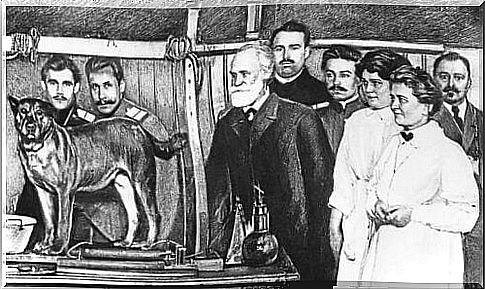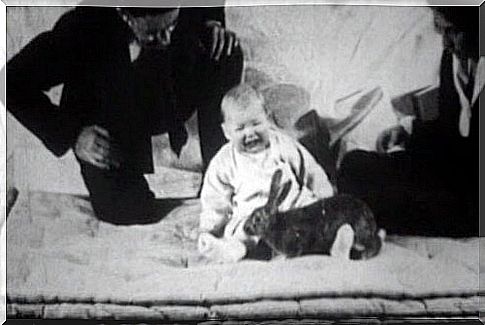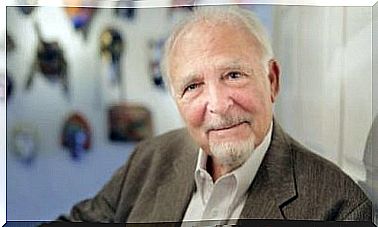Little Albert And The Rat: Ethics And Experiments

John B. Watson is known as one of the fathers of behaviorism. His greatest, and perhaps most important, intellectual inspiration was Pavlov. The Russian physiologist who made the first discoveries about conditioning. With this as his foundation, Watson conducted a famous study, often called the Little Albert Experiment, or “Albert and the Rat.”
Ivan Pavlov conducted an extremely well-known experiment with dogs. We can safely say that this experiment was one of the most important preliminary studies that helped to establish psychology as a true science. Pavlov discovered the basic aspects of stimulus response and then established the principles of classical conditioning.
Watson, in his attempt to replicate Pavlov’s experiment with dogs, came up with the little Albert experiment. In other words, he performed experiments on humans. In this very special case, he manipulated a baby to find evidence for his hypothesis.
Pavlov’s experiments
Ivan Pavlov was an amazing researcher. After studying several different disciplines, he discovered a deeper interest in physiology. And it was precisely a physiological element that allowed him to detect the phenomenon of conditioning, from the stimulus-response system.
Pavlov was researching the digestive system of dogs when he discovered that dogs began to salivate (excrete saliva) before being fed. In other words , he discovered that the dogs were preparing to eat before the food was served. They responded to a stimulus, namely the steps of the one who came with the food in the hallway outside. This observation inspired him to start experimenting. He later introduced a number of different stimuli before serving the dogs’ food, as a warning, in a way.

The most famous form of stimulus was a bell, but the truth is that Pavlov used many different auditory stimuli, including a flute, metronome and a tuning fork. It is not what stimuli he used that is important, but what he found. He proved that dogs would always salivate when they heard stimuli. They knew that the sound they heard was related to the serving of the food. Pavlov had conditioned them. The sound is the stimulus, which triggers the salivation, which is the response. This is classic conditioning.
Background information on the little Albert experiment
Watson was a radical positivist. He believed that human behavior should be studied solely based on behaviors already learned. Genetic, unconscious, or instinctive elements were meaningless to Watson. He only wanted to study behavior, or behavior, that he could actually observe.
Watson was a researcher at John Hopkins University in Baltimore. He began with the idea that most, if not all, human behavior could be explained by a person’s learning history based on conditioning. Because of this, he thought it would be a good idea to prove that Pavlov’s conclusions about conditioning could also be applied to humans.
Together with her assistant, Rosalie Rayner, Watson visited an orphanage. There they picked out a 9-month-old baby, the son of one of the nurses at the orphanage. The baby was often neglected and lived in a very cold and degrading environment. However, the baby appeared to be extremely calm. The staff at the orphanage said that since the birth he had hardly cried at all. This was the beginning of the little Albert experiment, one of the most famous in the history of psychology.
A controversial experiment
In the first phase of this experiment, little Albert was presented with various forms of stimuli. The goal was to observe which of these would create a fear reaction, in other words, which stimuli would frighten him. They eventually noticed that Albert only showed signs of fear when he was exposed to loud noises. This is a normal reaction in babies. Albert showed no signs of fear by being shown neither animals nor flames.
Then they began to evoke fear responses from little Albert through conditioning. They introduced Albert to a white rat. At first he wanted to play with it. However , every time Albert tried to play with the rat, Watson would produce a very loud and sudden sound (he hit a hammer on a steel pipe). This scared little Albert. After repeating this cycle, Albert ended up fearing the rat, even when loud noises were no longer produced. Then they continued to introduce Albert to other animals, such as rabbits and dogs, and even a fur coat. They ended up conditioning Albert on all these stimuli. He felt fear and dread when he was near all of them.

Conditional fear
They exposed the little baby to these experiments for a long time. The experiments actually lasted for almost a year. Eventually, this little boy went from being a calm baby to constantly showing signs of fear and anxiety. It went so far that little Albert even showed fear of a Santa Claus mask (the white beard may have resembled the original white rat for Albert). When they made him touch it, he began to cry incessantly.
During the second phase of the experiment, Watson decided to reverse the condition. This implies an extinction, or extinction, of the fear they had already established through conditioning. But, unfortunately, he was never given the opportunity to carry out this part of the experiment. Watson was fired and expelled from the university because of his controversial experiment and for starting a relationship with his assistant (who later became his wife).
Little Albert after the experiment
No one knows for sure what happened to little Albert after the experiment ended. However, there are researchers who have tried to find out what happened to the little boy. Some thought they found evidence that he had congenital hydrocephalus and died only 6 years old. Others believe that it can not agree with the boy from the film clips available from the experiment. They believe they found a man who fit the description. This man died 87 years old, and had a phobia of dogs. Whether he was the little boy, and whether his phobia stemmed from participating in the experiment is impossible to answer.
The Little Albert experiment is one of the most well-known studies in the history of psychology. The study’s findings, conclusions, and its many debatable flaws and shortcomings, made this a much discussed and controversial study. Studies such as this, Zimbardo’s prison experiment and others, led to a thorough examination of morality in psychology and the introduction of strict ethical guidelines. This experiment had never been approved today.









